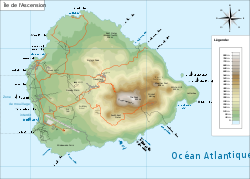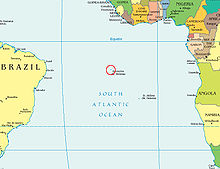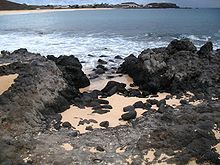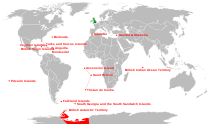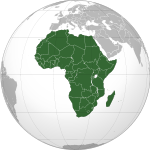- Ascension Island
-
Ascension Island 

Flag Coat of arms Anthem: God Save the Queen Capital
(and largest city)Georgetown
7°56′S 14°25′W / 7.933°S 14.417°WOfficial language(s) English Government British overseas territory - Queen Elizabeth II - Governor Mark Capes - Administrator Colin Wells Part of Saint Helena, Ascension and Tristan da Cunha - First inhabited 1815 - Dependency of St Helena 12 September 1922 - Current constitution 1 September 2009 Area - Total 88 km2 (219th)
34 sq mi- Water (%) 0 Population - estimate 880 (n/a) - Density 10/km2 (n/a)
25.9/sq miCurrency Saint Helena pound
(US dollars accepted) (SHP)Time zone GMT (UTC+0) Drives on the left Internet TLD .ac Calling code 247 Ascension Island is an isolated volcanic island in the equatorial waters of the South Atlantic Ocean, around 1,600 kilometres (1,000 mi) from the coast of Africa and 2,250 kilometres (1,400 mi) from the coast of South America, which is roughly midway between the horn of South America and Africa. It is governed as part of the British Overseas Territory of Saint Helena, Ascension and Tristan da Cunha,[1] of which the main island, Saint Helena, is around 1,300 kilometres (800 mi) to the southeast, and the territory also includes the "remotest populated archipelago" on earth, the sparsely populated Tristan da Cunha archipelago some thirty degrees farther south–about half the way to the Antarctic Circle.
The Island is named after the day of its recorded discovery, Ascension Day, and is located at 7°56′S 14°22′W / 7.933°S 14.367°WCoordinates: 7°56′S 14°22′W / 7.933°S 14.367°W, about as far south of the equator as tropical Venezuela is to its north. Historically, it has played a role as an important safe haven and coaling station to mariners and for commercial airliners during the days of international air travel by flying boats and during World War II was an important naval and air station, especially providing antisubmarine warfare bases in the Battle of the Atlantic and throughout the war.[2] Ascension Island was garrisoned by the British Admiralty from 22 October 1815 to 1922.
The island is the location of Wideawake Airfield, which is a joint facility of the United States Air Force and the Royal Air Force, a European Space Agency rocket tracking station, and the BBC World Service Atlantic Relay Station. The island was used extensively by the British military during the Falklands War. Ascension Island hosts one of five ground antennae (others are on Kwajalein Island, Diego Garcia, Colorado Springs and Hawaii) that assist in the operation of the Global Positioning System (GPS) navigational system.
Ascension Island, as a part of the wider overseas territory of Saint Helena, Ascension and Tristan da Cunha, does not yet have its own flag or coat of arms. The Union Flag and Royal coat of arms of the United Kingdom are used instead.
Contents
History
The Portuguese explorer João da Nova, sailing for Portugal, is believed to have been the first to discover the island in 1501, but his discovery was apparently not registered. Thus, in 1503 when another Portuguese navigator, Afonso de Albuquerque, sighted the island on Ascension Day in the church calendar, he named it after the feast day.[3] Dry and barren, it had little appeal for passing ships except for collecting fresh meat. Mariners could hunt for the numerous seabirds and the enormous female green turtles that laid their eggs on the sandy beaches. The Portuguese also introduced goats as a potential source of meat for future mariners.
In February 1701, HMS Roebuck, commanded by William Dampier, sank in the common anchoring spot in Clarence Bay to the northwest of the island. Some sixty men survived for two months until they were rescued. Almost certainly, after a few days they found the strong water spring in the high interior of the island, in what is now called Breakneck Valley (there is a much smaller water source, lower on the mountain, which was named Dampier's Drip by people who probably misinterpreted Dampier's story).[4]
It is possible that the island was sometimes used as an open prison for criminal mariners, although there is only one documented case of such an exile, a Dutch ship's officer, Leendert Hasenbosch, set ashore at Clarence Bay as a punishment for sodomy in May 1725. British mariners found the Dutchman's tent, belongings and diary in January 1726; the man had probably died of thirst.
Ascension Island was first inhabited in 1815, when the British garrisoned it as a precaution after imprisoning Napoleon I on Saint Helena to the southeast.[3] On 22 October the Cruizer class brig-sloops Zenobia and Peruvian claimed the island for His Britannic Majesty King George III. The Royal Navy officially designated the island as a stone frigate, "Royal Navy used the island as a victualling station for ships, particularly those of the West Africa Squadron working against the slave trade.[5] A garrison of Royal Marines was based at Ascension from 1823.
In 1836 the Beagle voyage visited Ascension. Charles Darwin described it as an arid treeless island, with nothing growing near the coast. Sparse vegetation inland supported "about six hundred sheep, many goats, a few cows & horses," and large numbers of guineafowl imported from the Cape Verde islands, as well as rats, mice and land crabs; he agreed with the saying attributed to the people of St Helena that "We know we live on a rock, but the poor people at Ascension live on a cinder". He noted the care taken to sustain "houses, gardens & fields placed near the summit of the central mountain", and cisterns at the road side to provide good drinking water. The springs were carefully managed, "so that a single drop of water may not be lost: indeed the whole island may be compared to a huge ship kept in first-rate order." In commenting on this, he noted René Primevère Lesson's remark "that the English nation alone would have thought of making the island of Ascension a productive spot; any other people would have held it as a mere fortress in the ocean."[6]
In 1843, botanist and explorer Joseph Hooker visited the island. Four years later, Hooker, with much encouragement from Darwin, advised the Royal Navy that with the help of Kew Gardens, they should institute a long term plan of shipping trees to Ascension. The planted trees would capture more rain and improve the soil, allowing the barren island to become a garden. So, from 1850 and continuing year on year, ships came each depositing a varied assortment of plants from botanical gardens in Argentina, Europe and South Africa. By the late 1870s, Norfolk pines, eucalyptus, bamboo, and banana trees were in lush profusion at the highest point of the island, Green Mountain, creating a tropical cloud forest.[7]
In 1899, the Eastern Telegraph Company (now part of Cable & Wireless Worldwide) installed the first underwater cable from the island, connecting the UK with its colonies in South Africa.[3] In 1922, Letters patent made Ascension a dependency of Saint Helena.[3] The island was managed by the head of the Eastern Telegraph Company on the island until 1964 when the British Government appointed an Administrator to represent the Governor of Saint Helena on Ascension.[3]
During World War II, to supply and augment extensive amphibious aircraft antisubmarine patrol operations ongoing from the early days of the war, the United States built an airbase on Ascension Island, known as "Wideawake",[3] after a nearby colony of Sooty Terns (locally called 'Wideawake' birds because of their loud, distinctive call, which would wake people early in the morning). The airbase, which was under construction by the 38th Combat Engineer Battalion of the Army Corps of Engineers, was unexpectedly visited by two British Fairey Swordfish torpedo planes on 15 June 1942. According to one of the pilots, Peter Jinks, the planes were fired upon before being recognised as allies. The Swordfish had to land on the unfinished airstrip, thus becoming the first land based aircraft to land on Ascension Island proper — which had long served as an ASW base for Catalina (PBY Catalina) flying boats. The event was later commemorated with a postage stamp 15 June 1982.
The Airfield was used by the US military as a stopping point for American aircraft crossing the Atlantic Ocean on the way to theatres of operation in Europe and Africa. American bombers based at Wideawake were engaged in the Laconia incident. After the end of World War II, and American departure, the airbase fell into disuse.
The only action during World War II occurred on 9 December 1941. At around mid-day, the U-boat U-124 approached Georgetown on the surface with the intention of sinking any ships at anchor or shelling the cable station. A two-gun shore battery at Cross Hill, above Georgetown, fired on the submarine. The guns scored no hits but the U-boat submerged and retreated. The battery remains largely intact to this day, together with its guns, BL 5.5 inch Mark I naval guns removed from HMS Hood during a refit in Malta in 1938.
With the Space Race and the Cold War, the Americans returned in 1956.[3] Wideawake Airfield was expanded in the mid 1960s. The runway, with its strange hump, was extended, widened, and improved to allow its use by large aircraft, and later to act as an emergency runway for the Space Shuttle, although the Shuttle never had occasion to use it.[3] The United States Air Force uses the island as part of its Eastern Range. NASA established a tracking station on the island in 1967, which it operated for more than 20 years before closing it down in 1990.[3] The island retains a role in Space exploration as the European Space Agency now operates an Ariane monitoring facility there.[3] The BBC Atlantic Relay Station was installed in 1966 for short-wave broadcasts to Africa and South America.
In 1982 a British task force used Ascension Island as a staging post during the Falklands War,[3] though according to Matthew Parris,[8] "...at the start of the Falklands conflict Washington at first refused Britain permission to use the USA-operated airfield facilities for refuelling RAF jets. Only after Mrs Thatcher intervened with Ronald Reagan did the Americans reluctantly concede." The Royal Air Force deployed a fleet of Vulcan bombers and Victor tankers at the airfield. The opening shots of the British offensive were launched from Ascension by Vulcans in Operation Black Buck. The RAF also used the base to supply the Task Force. Because of the increase in air traffic during the war, Wideawake was the busiest airfield in the world for a short period. The Royal Navy's fleet stopped at Ascension for refuelling on the way. Following the war, the British retained an increased presence on the island, establishing RAF Ascension Island, and providing a refuelling stop for the regular airlink between RAF Brize Norton in Oxfordshire, and RAF Mount Pleasant in the Falkland Islands.
As of 2007, NASA continues to list Ascension Island as a "downrange site" used for range safety instrumentation.[9] In particular, the Post-Detect Telemetry System used to acquire launch vehicle telemetry includes a station on Ascension.[10]
In 2008 British diplomats requested sovereignty, at the United Nations Commission on the Limits of the Continental Shelf (UN CLCS), over 77,220 square miles (200,000 km2) of submarine territory around the island. This would enable exploration into new reserves of oil, gas and minerals, though none are thought to exist.[11]
Politics
Ascension is part of a British overseas territory together with Saint Helena and Tristan da Cunha.[5] Executive authority is vested in Elizabeth II,[5] who is represented by the Governor of Saint Helena, Ascension and Tristan da Cunha. As the Governor resides in Jamestown, Saint Helena, an Administrator is appointed to represent the Governor on Ascension Island.
As a result of changes in the constitutional arrangements for Ascension Island, the first Island Council of seven members was elected and took office on 1 November 2002. This Council was dissolved by order of the Governor of Saint Helena on 24 October 2005, and a new election was held on 16 November 2005, a total of 697 electors choosing between ten candidates contesting the seven seats.[12]
Six of the seven members resigned in January 2007 in the belief that they were "assisting to legitimise a democracy that doesn’t really exist on Ascension Island".[13] Consequently, a general election was called, but by the close of nominations there were only two candidates. As a result of the boycott, the election was abandoned, and the governor suspended the Island Council for 12 months. It was stated that an election would take place in April 2008 but following consultations this was extended to October.[14] With eight nominations the elections were duly held and seven candidates were elected to form a new Island Council, which was sworn in on 28 October.[15]
Ascension Island has its own local system of law, much of which is based on the laws of Saint Helena and some parts of English law with modifications.[5] The Island Council advises on new or revised laws. Where local legislation does not exist, Saint Helenian law may be used where appropriate and suitable for local adaptation, or specific Ascension Island law is enacted. Employment legislation is a mixture of contract law and the Workmen's Protection Ordinance, which guarantees a contract, as well as obliging employers to provide free accommodation, medical cover, food (or a food allowance), travel etc.
The Saint Helena, Ascension and Tristan da Cunha Constitution Order 2009 was made by HM the Queen and the Privy Council on 8 July and came into operation in September 2009.[5] The new Constitution replaces the 1988 version and among other changes limits the Governor's powers, includes a Bill of Rights, establishes independence of the judiciary and the public service and formally designates the Governor of St Helena as, concurrently, the Governor for Ascension and Tristan da Cunha. It also ends the "dependency" status of Ascension and Tristan da Cunha on Saint Helena that had been in place, for administrative convenience, since 1922.[16]
Geography and ecology
See also: List of mountains and hills of Saint Helena, Ascension and Tristan da CunhaThe main island has an area of approximately 91 km2. A volcanic peak rising from just west of the Mid-Atlantic Ridge, much of the island is a wasteland of lava flows and cinder cones; no fewer than forty-four distinct dormant craters have been identified.[5]
The island originally had its own native flora until Portuguese explorers released goats in the 1500s which ate much of it. The later introduction of rabbits, sheep, rats and donkeys, and over 200 imported species further marginalized the original flora.[17] By 1843 the island was barren with few plants. However, due to the introduction of species by the British, Ascension Island's Green Mountain is now one of the few large-scale planned forests, and is gradually growing with each year. Its highest point is at 2,817 feet (859 m).[5]
Off the east coast of Ascension is the islet of Boatswain Bird Island. It is a haven for sea birds providing refuge from the rats, cats and people that came to Ascension Island from Europe and Africa. Following a successful campaign headed by the Royal Society for the Protection of Birds, the main island was in 2006 declared free of feral cats, and sea birds are now once again nesting on Ascension Island.
Ascension's climate is tropical, with temperatures at the coast ranging from about 68 to 88 degrees Fahrenheit (20–31 °C), and about 10 degrees Fahrenheit (5 to 6 degrees Celsius) cooler at the highest point. Rain showers may occur at any time during the year, but tend to be heavier between January and April.
Flora and fauna
Main article: Ascension scrub and grasslandsThe endemic flora includes plants like Pteris adscensionis, Asplenium ascensionis, Euphorbia origanoides as well as the extinct species Oldenlandia adscenionis, Sporobolus durus and Dryopteris ascensionis and the recently rediscovered Anogramma ascensionis (Ascension Island parsley fern).
In June 2005 the first National Park on Ascension Island, the Green Mountain National Park, was opened. Non-indigenous plants teem there, and the crown of Green Mountain is a lush halo of bamboo. Flanking one side is a large stand of tall Norfolk pine, trees planted by British mariners, which were to have been used as replacement masts for sailing ships.
A few wild flowers narrowly abound such as periwinkle; cactus is present with land crabs in several large colonies near the sea and mountains. Prosopis juliflora, or the Mexican Thorn, is an introduced species which has thrived on the barren lava of the island in recent years; however, its spread has been destructive to other species, and current encroachment on the edges of beaches threatens those that utilize this space, such as the green turtle.[18]
The protected green turtle is perhaps the most notable of the endemic fauna, coming ashore to lay their eggs on the beaches from November to May. Sooty Terns or "Wideawake Birds" nest in great seashore lava "fairs". Other seabirds include some types of boobies, petrels and tropicbirds (named boatswain (pronounced BO-sun) birds by the inhabitants of the island), White Tern, Brown Noddy, Black Noddy and Ascension Frigatebird. The Ascension Crake became extinct around the beginning of the 19th century. Following the eradication of feral cats from the island, several species of seabird previously confined to Boatswain Bird Island are making a return to the main island.[18]
On land are found such non-native birds such as canaries, francolins, mynas, sparrows, and waxbills. A variety of mammals have been introduced: donkey, sheep, cats and rats among others. Reptiles consist of two species of lizards. In summer, flies are known to be problematic.
The largest native land animal is the land crab Johngarthia lagostoma (formerly Gecarcinus lagostoma).[19]
Offshore, there is a variety of open-ocean fish, including sharks, wahoo, tuna, bonito, barracuda, marlin, blackfish and sailfish.
Demographics
Georgetown seen here is the primary settlement on the island and comprises the post office, police station, court, government house and the island's supermarket. It also boasts the island's port: a small pier where supplies are off-loaded and a connection exists for a pipeline hose for fuel.
There is no indigenous or permanent population on the island, although around 880 people live there as of 2010[update]: 696 from Saint Helena nicknamed the "Saints"[20] (who are British citizens), 106 British citizens from Great Britain, 70 US citizens and 12 of other nationalities.[21] RAF Ascension Island is made up of 17 staff.
There are five settlements:
- Georgetown (the main civilian settlement and capital of the island)
- Two Boats (a civilian village, with its school)
- Cat Hill (the United States' main base on the island)
- Traveller's Hill (Royal Air Force base)
- Wideawake Airfield (with the Royal Air Force station)
Additionally, there are some cottages on Green Mountain, occasionally occupied by visitors, and the Residency, the official residence of the Administrator.
In order to enter Ascension Island, people need the written permission of the Administrator. There is no permanent residence. A contract of employment is a requirement to stay on the island,[20] though short term visits by tourists are possible with prior approval. The British government has asserted that there is no "right of abode" on Ascension Island.[22] As the local newspaper The Islander reported at the time,[23][24] it is an issue that was disputed by some former Council members and some of the long-time expatriate employees.
Society and culture
See also: Scouting and Guiding on Saint Helena, Ascension and Tristan da CunhaThere are scouting and guiding groups on Saint Helena and Ascension Island. Scouting was established on Ascension Island in November 1973,[25] having been established on St Helena island in 1912.
Two Boats School is the only school on the island and provides education to all resident children aged 31⁄2–16.
Economy
The main economic activity on the island is centred on the military bases at Wideawake Airfield, and the BBC World Service's Atlantic Relay station. The Ministry of Defence estate and facilities are currently managed by the infrastructure support provider Interserve Defence. Serco currently manages the airport services with Sodexo providing catering and domestic facilities. A former feature of Ascension was a 70,000 tonne tanker permanently moored offshore that was operated by Maersk as a bulk fuel facility. In December 2002, this was replaced by an on-shore Petroleum Supply Depot under military management, with fuel still being delivered by a chartered tanker; the Maersk Rapier, which operates on an MOD resupply contract for both Ascension and the Falkland Islands every 2 months. Fuel for the island is transferred via a floating hose, which is connected to the on-shore depot at the islands pier head and to the ship, once it is anchored off Georgetown.
The main export items are Ascension Island postage stamps, first issued in 1922, and, since 2010, commemorative coins (which are legal tender but non-circulating) and commercial fishing licences for long-line tuna fishing vessels operating to ICCAT quotas.
A secondary export is the international internet domain code .ac, which small UK educational colleges and science museums are favouring due to its similarity to .ac.uk, the domain code reserved for well established UK educational institutions.
Until 2002, tourism was virtually non-existent because of the inaccessibility of the island to transport, the absence of guest accommodation and the need for a sponsor. Limited air travel has, however, been made available in recent years to the public by the RAF, and the Georgetown Obsidian Hotel together with a number of guest cottages that have been opened. All visitors are required to obtain an entry permit before travelling. Sport fishing is the main attraction for many of the visitors. The Island also boasts what was once officially the worst golf course in the world. That course, on the outskirts of Georgetown has since been replaced with a similar one located between the settlements of Two Boats village and Georgetown, the course has 18 holes and the greens are in fact 'browns', a reference to the sand and oil mix used to make them. The rest of the course is made up of volcanic ash and rocks.
Communications
The island hosts many communications and relay stations, exploiting the Island's strategic position in the middle of the Atlantic Ocean. Both the BBC and Cable & Wireless Worldwide have communications posts there. The European Space Agency (ESA) also has a tracking station on the island that tracks the Ariane 5 rockets shortly after they take off from Kourou in French Guiana.
Ascension has one local radio station and one relayed from St. Helena. It also receives broadcasts from the British Forces Broadcasting Service and television services for the US military.[5]
Ascension Island has the international calling code +247 and has 4 digit numbers on the island.[26]
Banking and currency
The Bank of St. Helena has a branch on the Island. This bank holds an account with Lloyds TSB in the United Kingdom for the purposes of conducting money transfers with the rest of the world.[27] The currency on Ascension Island is the Saint Helena pound. Tristan da Cunha however uses the pound sterling rather than the Saint Helena pound. The coins of the Saint Helena pound specify that they are for use on both Saint Helena and Ascension Island, but with no mention of Tristan da Cunha. For more information on currency in the wider region, see Pound sterling in the South Atlantic and the Antarctic.
Transport
In 2003 the British and US governments signed the Wideawake agreement designed to allow a limited amount of non-scheduled civilian aircraft to land on Ascension Island, under responsibility of the British government.[28][29] The island has a regular airlink with the United Kingdom and the Falkland Islands, with twice weekly flights from the RAF Ascension Island to the UK (RAF Brize Norton) and to the Falkland Islands (RAF Mount Pleasant). These are chartered civilian Boeing 767 aircraft operated by Titan Airways (previously by Air Seychelles) on behalf of the Royal Air Force, however a limited number of commercial passenger tickets are available. All visitors to Ascension Island need the Administrator's written permission before travelling.[30] The United States maintains a weekly flight between the island and Patrick Air Force Base in Florida for the use of its personnel only.
The RMS Saint Helena visits Ascension Island approximately once a month linking the island to St Helena and Cape Town. The US military service their base and facilities with a regular supply ship (MV Ascension) and air transport.
There is no taxi service on the island and most visitors requiring transport hire a car. There are around 40 kilometres (25 mi) of roads on the island, all of which are surfaced.[5] Some sections of the surfacing was done using surplus tarmac from construction of the airstrip.[20] Traffic drives on the left.[20]
See also
- Outline of Ascension Island
- Index of Ascension Island-related articles
- Anglican Diocese of Saint Helena
- Diego Garcia
- Saint Helena
- Tristan da Cunha
Bibliography
- Duff Hart-Davis, Ascension, the story of a South Atlantic island, p. 15
- Correspondent's diary: Ascension Island | The Economist
- Official Ascension Island Government site
- – Global Volcanism Program: Ascension Island
- Sanders, Sarah, Important Bird Areas in the United Kingdom Overseas Territories; priority sites for conservation (RSPB, 2006)
- Stonehouse, Bernard. (1960). Wideawake Island. The Story of the BOU Centenary Expedition to Ascension. Hutchinson: London
References
- ^ The St Helena, Ascension and Tristan da Cunha Constitution Order 2009, see "EXPLANATORY NOTE"
- ^ Victory at Sea (Series title), Volume-10 "Beneath the Southern Cross" 1952 production of NBC, (Disc 2 of DVD collection reproduction ca. 2007-2008)
- ^ a b c d e f g h i j k "Ascension History". mysterra.org. Mysterra Magazine. http://www.mysterra.org/webmag/ascension-island/history.html. Retrieved 03 January 2011.
- ^ see Duff Hart-Davis, Ascension, the story of a South Atlantic island.
- ^ a b c d e f g h i "Saint Helena, Ascension, and Tristan da Cunha". The World Factbook. Central Intelligence Agency. https://www.cia.gov/library/publications/the-world-factbook/geos/sh.html. Retrieved 2011-01-03.
- ^ Keynes 2001, pp. 431–432
- ^ "Charles Darwin's ecological experiment on Ascension isle". BBC News. September 1, 2010. http://www.bbc.co.uk/news/science-environment-11137903. Retrieved September 1, 2010.
The parable of Green Mountain: Ascension Island, ecosystem construction and ecological fitting, David M. Wilkinson, Journal of Biogeography, 22 December 2003 DOI: 10.1046/j.0305-0270.2003.01010.x - ^ Parris, Matthew (27 February 2010). "Think of Hong Kong. Give the Falklands back". London: The Times. http://www.timesonline.co.uk/tol/comment/columnists/matthew_parris/article7043099.ece.
- ^ "NASA Range Safety Program – 2007 Annual Report". NASA. pp. 60. http://kscsma.ksc.nasa.gov/Range_Safety/Annual_Report/2007/PrintPages/RangeSafetyReportnoImages.pdf.
- ^ "NASA Range Safety Program – 2007 Annual Report". NASA. pp. 62. http://kscsma.ksc.nasa.gov/Range_Safety/Annual_Report/2007/PrintPages/RangeSafetyReportnoImages.pdf.
- ^ Lewis, Paul; Paul Lewis (2008-08-28). "Ascension Island. Barren, 4,044 miles (6,508 km) from Land's End, but ours says the FO". The Guardian (London: Guardian Newspapers): pp. 1. http://www.guardian.co.uk/politics/2008/aug/28/foreignpolicy.unitednations. Retrieved 2008-08-28.
- ^ Juanita Brock, Ascension: Ascension Island Votes for Councillors
- ^ Road Repairs – Ascension Island News
- ^ Ascension Island Council
- ^ See http://www.the-islander.org.ac/
- ^ http://www.the-islander.org.ac/artd_6748_07_2009_21.html
- ^ native flora
- ^ a b ProcPt5b
- ^ Richard G. Hartnoll, Annette C. Broderick, Brendan J. Godley & Kate E. Saunders (2009). "Population structure of the land crab Johngarthia lagostoma on Ascension Island" (PDF). Journal of Crustacean Biology 29 (1): 57–61. doi:10.1651/08-2992.1. http://www.seaturtle.org/PDF/Hartnoll_2009_JCrustacBiol.pdf.
- ^ a b c d "Ascension Population". mysterra.org. Mysterra Magazine. http://www.mysterra.org/webmag/ascension-island/population.html. Retrieved 03 January 2011.
- ^ "About Ascension". http://www.ascension-island.gov.ac/about.
- ^ "CONSTITUTION OF ST HELENA, ASCENSION AND TRISTAN DA CUNHA DRAFT FOR PUBLIC CONSULTATION OF 25 JUNE 2008". http://www.sartma.com/artd_5474_06_2008_9.html. Retrieved 2009-06-03.
- ^ "FOREIGN AFFAIRS COMMITTEE — SELECT COMMITTEE ANNOUNCEMENT (04 JULY 2008)". http://www.the-islander.org.ac/art_5535_16_41_1.html. Retrieved 2009-06-03.
- ^ "Letter's To FCO From Cyril Leo". http://www.the-islander.org.ac/art_4907_16_75_1.html. Retrieved 2009-06-03.
- ^ The Ascension Island Newspaper November 1998
- ^ World Telephone Numbering Guide Ascension Island
- ^ the Bank of St. Helena
- ^ "AGREEMENT BETWEEN THE GOVERNMENT OF THE UNITED KINGDOM OF GREAT BRITAIN AND NORTHERN IRELAND AND THE GOVERNMENT OF THE UNITED STATES OF AMERICA CONCERNING THE USE OF WIDEAWAKE AIRFIELD ON ASCENSION ISLAND BY CIVIL AIRCRAFT NOT ENGAGED IN SCHEDULED INTERNATIONAL AIR SERVICES." 1 October 2003. United Nations Treaty Collection, Volume 2270, I-40420. Retrieved on 10 August 2010.
- ^ "Information for Aviators" Ascension Island Government. Retrieved on 10 August 2010.
- ^ "GUIDANCE NOTES: APPLICATION FOR AN ASCENSION ISLAND ENTRY PERMIT" Ascension Island Travel Agency. Retrieved on 10 August 2010.
- Keynes, Richard (2001), Charles Darwin's Beagle Diary, Cambridge University Press, http://darwin-online.org.uk/content/frameset?itemID=F1925&viewtype=text&pageseq=1, retrieved 2010-09-19
External links
- Ascension Island Government
- Ascension Island Newsletter
- Ascension Conservation
- Rocket launches from Ascension
- Detailed description of the BBC Atlantic Relay Station
- CIA World Factbook entry about Saint Helena, Ascension, and Tristan da Cunha
- Live Web Cam of Ascension
- Colonial History of Ascension Island
- Google Satellite View
- Ascension Island at Britlink – British Islands & Territories
- Army Ornithological Society Ascension Island Research
- James Rogers and Luis Simón. The Status and Location of the Military Installations of the Member States of the European Union and Their Potential Role for the European Security and Defence Policy (ESDP). Brussels: European Parliament, 2009. 25 pp.
 Saint Helena
Saint HelenaAscension Island  Tristan da Cunha
Tristan da CunhaJamestown (capital)
Half Tree Hollow
Saint Paul's
LongwoodGeorgetown (chief settlement)
Two Boats Village
RAF Ascension IslandCategories:- Ascension Island
- Volcanoes of Ascension Island
- English-speaking countries and territories
- States and territories established in 1922
Wikimedia Foundation. 2010.

